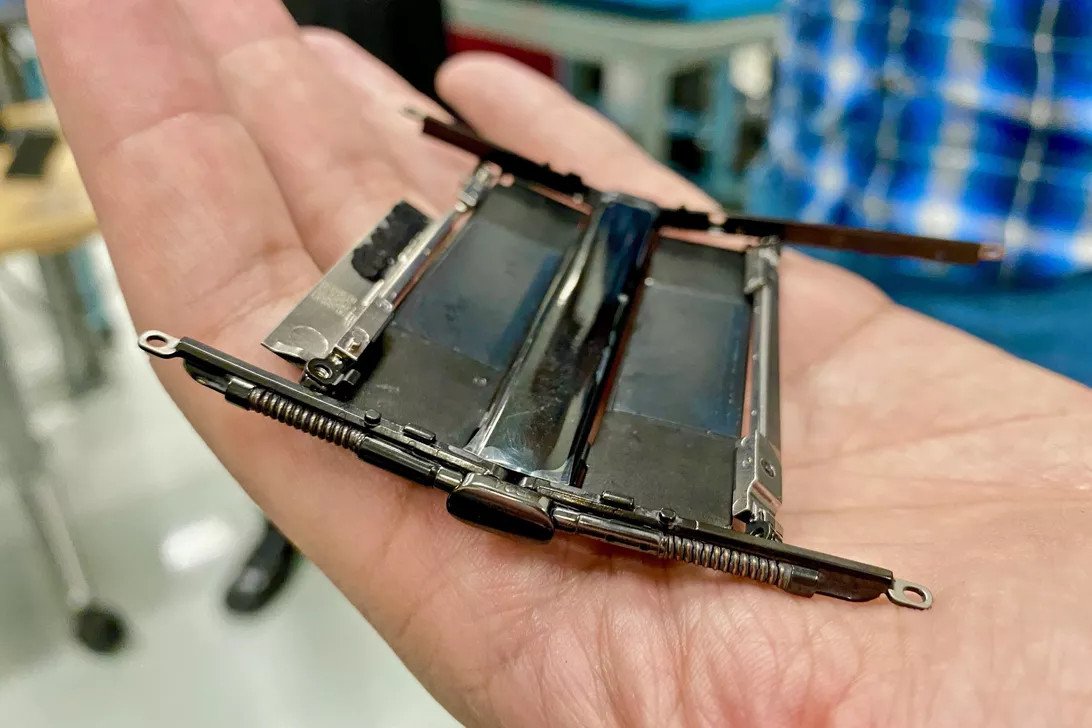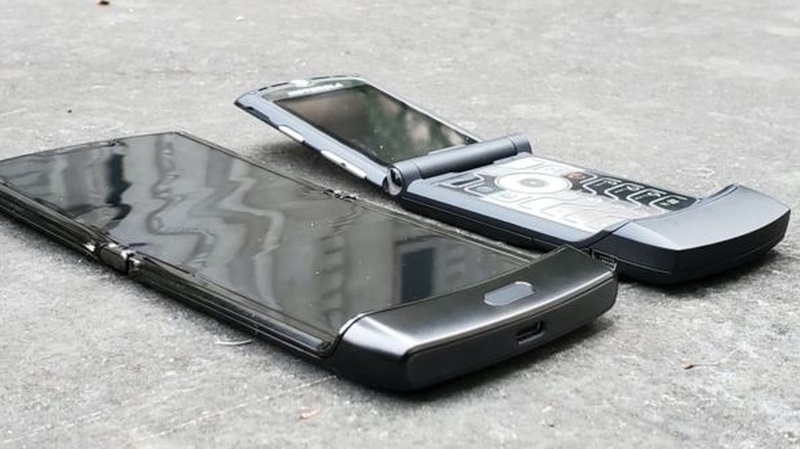If you’re the kind of person who hates this new generation of smartphone users and longs for a nostalgic past, you’re not far from the new target demographic for many commercial phone manufacturers. Major phone companies like Motorola and Huawei have been developing foldable versions of conventional smartphone designs, intended to be more versatile while maintaining the same functionality as their less flexible counterparts.
It’s certainly gimmicky, but phones like the Samsung Galaxy Fold, the Motorola Razr, and the Huawei MateX are elegant from an engineering perspective. Developing a seamless interface experience, maximizing surface area for functionality, and maintaining the same nostalgic flip phone aesthetic while making use of familiar smartphone features isn’t an easy design process.

For the Razr, a hinge system that takes up about a third of the phone’s internal space allows the OLED display to have no noticeable binder line. Rather than curving like a piece of paper, it forms a teardrop shape that prevents the screen from creasing and being damaged. Springs and pistons below the surface move small places underneath where the user will be tapping – folded in, the plates slide away. It’s an interesting effect, although as you can see in the banner image, it doesn’t quite achieve optically flat perfection.
In order to ensure that the screen doesn’t overheat as it bends, it is made up of microlayers sandwiched together. To balance weight, the circuits and battery is split into two, operating on each half of the device, an unusual design choice for smartphones. Placement of the array of radios and antennas is also a challenge since they can’t be too close to each other or the processor, which can interfere with signal transmission.
Other devices like the Royale Flexpai are more so proof-of-concepts making use of flexible screens and batteries, rather than capturing the aesthetics of a flip phone generation — but who doesn’t want their smartphone to unfold into a tablet when needed? The future of smartphone technology is looking interesting, and we’ll be sure to see even more iterations of flexible displays in the near future.

















Absolutely ridiculous.
Why is this “ridiculous”?Not everyone has” sold their soul”2 the internet,🤪. Alot of peeps still want a cool-looking phone just for 👍 “the basics”
How about shrinking this down to the Star TAC size?
Now that was an excellent phone! I had several of them back in the day.
I miss my LG Lotus : (
The Kyocera echo was ahead of its time.
I still have two of the old ones and they still work!
I still use a flip phone – largely because I only call & text, and because I want real keys to touch. These new facsimiles are not the same animal.
More durable too. Plus some people are intimidated by these newfangled touch screen phones with a gazillion things to go wrong.
Flip phone user here as well!
Absolutely ideal for voice calls. Hate to talk to thin air. Better the curvy “handset” created by an opened flip phone whereas you talk straight into the microphone area.
Cannot understand why they don’t work on that idea and produce a new device, usable and functional. Why only small “tablets” …
Moving parts arw often unreliable. When they are reliable, they’re usually heavy or expensive.
This takes up a third of the internal space. Battery life might suffer.
There’s noticable wobbliness to the screen when off. Is there distortion when on? Will there be in two years?
The cool way to do a flip phone would be dual screens, and to put everything besides the content (The clock, keyboard, battery status, even the browser URL bar maybe) on the bottom screen.
With the keyboard open, content is about half the screen, so it should fit nicely in two screens.
Reminds me of Microsoft’s Surface phone with a dual hinged screen.
Motorola’s design is pretty ingenious, even if it doesn’t make for a mirror flat look.
One of the phones that I loved the most wasn’t a flipper ( I had my share, mostly Samsungs) but a slider, Samsung SGH-E250.
Still, both options gave that comfortable slam-it-in-your-face feel when the call was over.
I don’t know if these new ones will take that abuse.
Slider mechanism would sometimes fail.
I just hope that this paves the way for a new race to make the smallest phone again. With new display tech coming out in the coming years I’m hoping it will be possible to have the best of both worlds.
Foldable is not the same concept – hinges are a good thing – imagine if the doors in your house were only bendable flaps, rather than rigid with hinges! Think about the size & shape of historic phone handsets – they were designed to complement the human head – there was a physiology-inspired distance between the microphone and speaker, based on the distance from the mouth to the ear! With a curve to it! Overall, smartphones are an ergonomic disaster! The geometry is all wrong, and the idea of a touch-screen that one holds up to the ear is – ridiculous! The “flip phone” is the only natural solution to allow a portable phone to be physically extended for an actual phone call. Here’s what some company should develop: a smart flip-phone, with the touch-screen on the bottom (mouth/microphone) end, and the camera lenses & larger speaker on the top (ear/speaker) end.
I live with two people who are electronically incapable. Neither can use a computer. Looking for replacement flip phones is becoming more and more challenging. I am glad to hear this. Only one knows how to read texts and neither knows how to send them. So they only need the phone feature.
Just make a better stronger more stylish flip phone with a better camera . Do need a computer in my pocket…..got plenty at home,.
My husband only uses fill phones. He’s a builder and is hard on phones. Wish it was easier for him to text when he has to though.
It also stops you pocket dialing
i have a big smartphone, a note 10+ and what i also have a a bluetooth dialer so i dont have to always get my smartphone just to answer or make a phonecall, (search amazon for bluetooth dialer, they have some that look like old nokia 3110 feature phones only smaller
I had one of those, it was terrible even back then
I have AT&T Samsung Rugby 2 and Nextel Motorola i530. I’ll near sale or give away and if the flip phone does come back that’s great. I do like the smartphones their like mini me tablets that don’t take up to much space like that tablets we have today .
Using a flip phone keeps one from being a total slave to the flat block in one hand. That way the flat block won’t take over your life. It’s amazing what Life has going on all around us!
I think the flip phones are magnificent and they have versatility go flippers
Can you upgrade the antenna to 4g and put a sim card in it to keep it alive longer?
Surely you are joking… since the radio doesn’t support any new bands.
Among other strange evolutionary phone developments is the lack of ear-to-mouth alignment. This results in having to hold the phone horizontally, pointing one end to your pie hole when talking and then the other end to your ear when listening. Over.
I dunno if I’d call the folding screen elegant engineering. Overcomplicated, fragile, gimmicky, unnecessary, textbook case of function following form. It’s Jonny Ives style design. Increasing glamour at the expense of usability. It’s trendy, “futuristic,” it gets drool going. It’s cool. People will buy it.
But that is not what elegant engineering is about. That needs to be simple, reliable, efficient, and directly answers utilitarian need instead of whims of marketing. It’s hard to even find a place that will let elegant engineering happen, because it’s not the biggest profit maker. At least short-term. So it’s not really their fault. It’s quite a feat; they did their best with what they had.
Maybe this feels like a silly distinction, but saying this is elegant engineering is like saying code is elegant because it’s “clever,” if you know what I mean. Elegant and snazzy are different.
I will be interested when reliable stretchable phones are available.
Somewhere between 10cm (4″”) or less when in your pocket or for simple tasks such as calling, and at least 42cm (17″) for more screen intensive tasks.
In the last 10 years smart phones have evolved from “crammed full of electronics and still pretty slow and battery hungry”, to “powerfull beasts with a medice battery life”. I’m not sure but I think that for most users it will not be very usefull to cram more processing power into a phone than it has now, which naturally focusses more onto shrinking the electronics and power consumption.
If Moore continues in any way in the phone world, then in 10 years time a smartphone will fit in a sugar cube and a coin cell as battery will last a few months.
Stuff like stretchable screens would be needed to keep up with that.
You remember those old Sony hand held TVs, the ones with the CRTs that reflected the image on to a screen, why not adopt a similar approach to the flip smart (smart flip?) phone, have a foldable touch screen (which I think is doable) and have the image projected on to the back of the touchscreen?
Sand and dirt buildup would wreck these phones, much more so than our standard brick formats nowadays.
Making things worse for flip phone users, T-Mobile is shutting down their 2G network in 2021. They’re the last US carrier covering 2G, so all those old 2G phones will be bricked! The same is happening to 3G… although I think Sprint will keep supporting existing 3G phones for a couple more years (but won’t activate them anymore).
I really love my old Razr V3, but I never carry a phone for actual phone stuff, like calls and texts, any more. So pretty much pointless really.